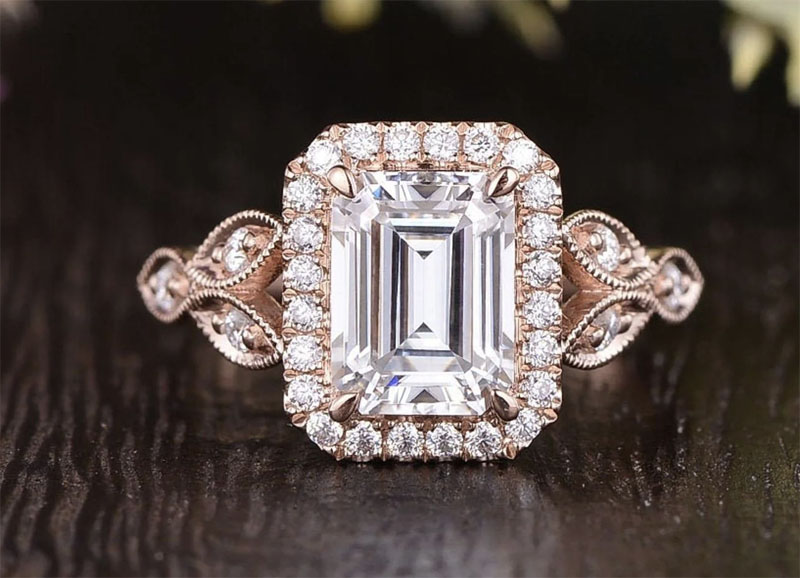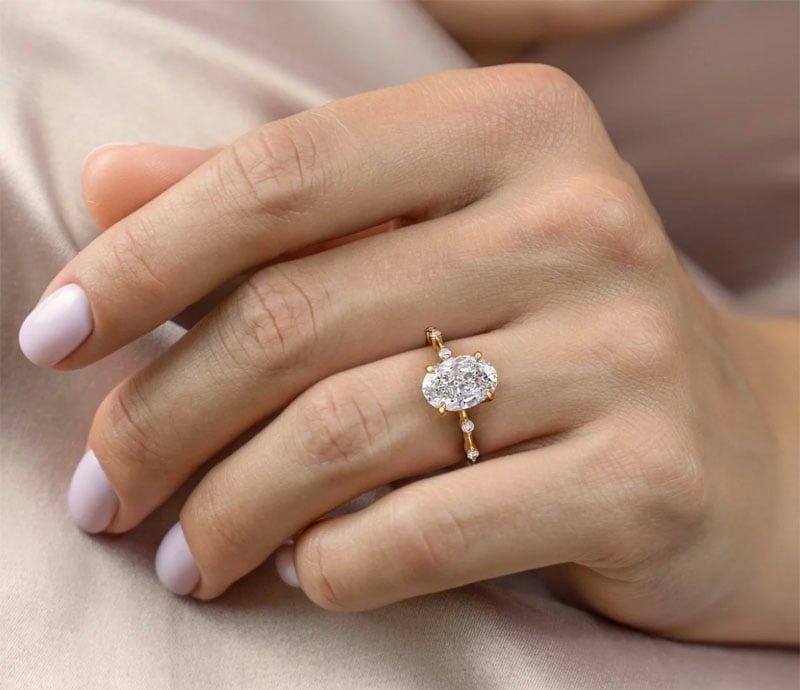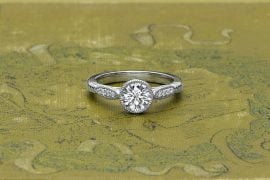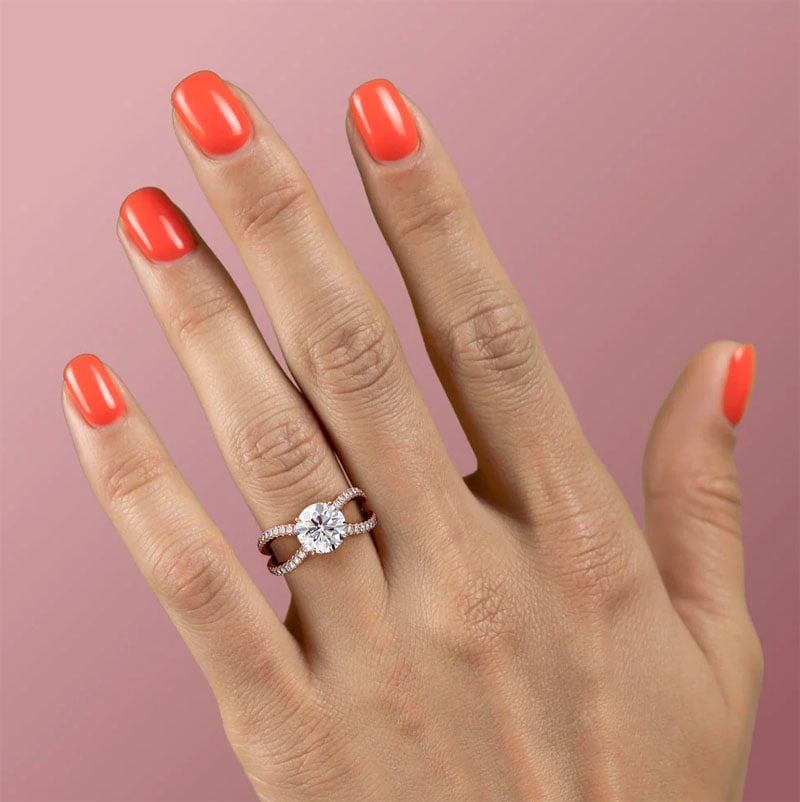
Let’s be honest: When it comes to shopping for engagement rings, it’s easy to get carried away by the sparkle. Once you see it, a multi-carat diamond in a gorgeous setting will have you doing some creative math to try and fit it into your budget. The good news? You can get a nearly identical stone for more than 60% less if you go with a lab-grown alternative, including diamond and moissanite rings. If you thought that sounded like a much better idea, you wouldn’t be alone! Sales of lab-grown alternatives have nearly doubled since 2020, and now account for 36% of all center stones. Crazy, right? Well, not really, especially if you think about all the benefits of lab-grown gems, including the ethical and environmental concerns with their traditional counterparts.
Why Moissanite Engagement Rings are Exploding in Popularity
In additional to lab grown diamonds, moissante rings have been exploding in popularity, and with good reason. To the average, untrained eye, it’s hard to tell the difference between moissanite and diamonds. They look nearly identical, and in fact a moissanite has even been said to have more “sparkle,” or “fire” due to it’s higher refractive index (a moissanite has a value of 2.65-2.69, while a diamond has a refractive index of 2.42.). And, let’s talk about price. The pictures below shows a Flawless Moissanite round cut halo ring on the left that features a 2 carat moissanite with a platinum band) on sale for $1,460. On the right is Tiffany’s Soleste® Round Brilliant Engagement Ring in platinum with a 1.66 carat F color diamond for $58,500.
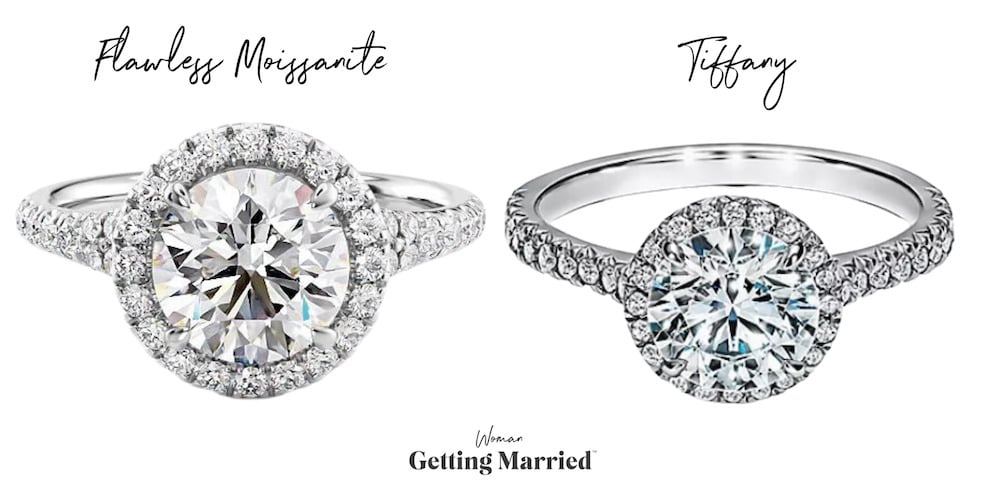
While the price of moissanite rings along with their appearance seems to make them a great alternative to diamond engagement rings, what else do you need to know? Read on to find out more about moissanite’s history, what you need to watch out for, and where to buy.
The History of Moissanite Rings
In 1893, when checking out some rock samples from Arizona’s Meteor Crater, Dr. Henri Moissan found crystals he first thought were diamonds. Turns out, they were silicon carbide, later named “moissanite” in his honor. Although Dr. Moissan’s early claim to fame was this sparkling find, his later works earned him the Nobel Prize in Chemistry in 1906.
For years after his discovery, naturally occurring moissanite remained a rare gem, mostly confined to meteorite craters. Realizing its potential as a gemstone, researchers in the late 20th century began efforts to create it in labs. By the 1990s, through advanced technology, they succeeded in consistently producing gem-quality moissanite. Now a hit in the jewelry market, it’s an ethical and eco-friendly alternative to traditional gemstones. While today’s pieces might be lab-made, the gem’s origin tale does have that sprinkle of celestial magic, stemming from that initial meteoric find.
Can Moissanite Pass for a Diamond?
Ah, the age-old question: Can moissanite really pass for a diamond? The short answer is yes! A jeweler will obviouisly know the dfference, but to the untrained eye they are remarkably similar.
When it comes to brilliance, bothdiamonds and moissanite reflect light beautifully. In fact, moissanite has a higher refractive index than diamonds, which means it can exhibit more “fire” or the colorful flashes you see under light. The Gemological Institute of America (GIA, the most respected authority on diamonds in the world) actually rates moissanite “superior’ to diamonds in “overall appearance and heft.“
Moissanite is also extremely durable, just like a diamond. On the Mohs scale of hardness, diamonds score a 10, making them the hardest known mineral. Moissanite isn’t far behind with a rating of 9.25, making it hard and durable enough for everyday wear year after year.
While their origins are different (diamonds are formed deep within the Earth over billions of years and moissanites are primarly lab-created), their cuts and color are similar. For instance Flawless Moissanite, one of the top retailers of moissanite engagement rings, features colorless and near-colorless moissanite rings, available in all the same cuts, settings and configurations as diamonds.
The main difference between moissanite and diamonds might very well be the conflict around their origins. There is more and more demand for ethically sourced and environmentally-friendly gemstones, and moissanite tops the list. Because it’s lab-crafted, there’s no mining involved, which means it’s better for the environement and eliminate any ethical dilemmas with trade. It’s 100% traceable, with eco-friendly origins to boot.
How Much Do Moissanite Engagement Rings Cost?
Moissanite engagement rings have gotten more popular in recent years due to their afforabilty as well as ethical sourcing, among other benefits. But how much do they typically cost, especially when compared to their diamond counterparts?
The cost of a moissanite engagement ring is influenced by several factors:
- Size of the Stone: Like diamonds, the larger the moissanite, the higher its price. However, moissanite, carat for carat, is significantly less expensive than diamonds.
- Quality of the Stone: While moissanite is almost always near-colorless, slight variations can exist. The clearer and more colorless the stone, the higher its price.
- Shape and Cut: Certain shapes and cuts might be pricier due to their demand or the intricacy of the cutting process.
- Setting and Design: The complexity of the ring’s design and the type of metal used can also influence the price. For instance, platinum settings cost more than white gold. However you can also save big by going with recycled gold, which some higher-end companies are offering as well.
Average Price Range:
Moissanite engagement rings can range widely in price, typically from $300 to $4,000. For a one-carat moissanite engagement ring, you might expect to pay anywhere from $300 to $1,200, depending on the factors listed above. Conversely, a one-carat diamond ring can often range from $2,000 to $25,000+ based on its quality, cut, clarity, and color.
On Flawless Moissanite, prices for their moissanites ranged from $150 for 1 carat to $1,150 for an 8-carat loose cushion cut moissanite. That’s compared to $1,400 for a 1 carat natural diamond (SI1) on Blue Nile, and $1,000 for a 0.9 carat lab-grown diamond.
Does Moissanite Get Cloudy?
You might be wondering if moissanite gets cloudy as the years go by. Well, good news—it doesn’t. Moissanite is incredibly resilient and maintains its clarity throughout its lifetime, just like when you first lay eyes on it.
Now, like any gem, it can gather a bit of daily life on it—think oils, dirt, or even that hand lotion you love. When that happens, it might seem a touch less sparkly or appear slightly “cloudy.” It’s really just what’s on the surface. A gentle cleaning, and it’s back to its brilliant self.
WGM Says: Moissanites should be cleaned gently just like diamonds. Here’s how to clean your engagement ring.
It’s worth noting that the early versions of moissanite weren’t quite as crystal clear as what we see today. So, if you ever come across a piece from years back, it might seem different from the pristine stones available now. Today’s high-quality moissanites? They’re consistently clear and ready to dazzle.
And just a quick tidbit: Some stones, like white sapphires, can be affected by certain conditions, making them appear cloudy over time. But moissanite? It’s steadfast in its brilliance, much like diamonds. So if you’ve chosen moissanite, rest assured you’ve got a gem that’s in it for the long haul!
Where to Buy Moissanite Engagement Rings
There are several online retailers (as well as local jewelers) where you can find moissanite engagement rings. Brands that top our list include Flawless Moissanite, Brilliant Earth, and Charles & Colvard. As you would shopping for a diamond engagement ring, make sure you’re buying from a trusted retailer that has a generous return policy (30 days) and satisfaction guarantee. One of our top picks, Flawless Moissanite, offers a 12 month warranty covering any defects with the setting, and a lifetime warranty on their moissanite stones.
If you’re looking for an environmentally-friendly and extremely affordable stone for your engagement ring, it’s hard not to look at moissanite as an option. With it’s growing popularity and diamond-like qualities (only the good ones!), it’s become harder to justify a traditional diamond’s cost.
Would you consider a moissanite engagement ring? Let us know in the comments section, below!
All products featured on Woman Getting Married are independently selected by our editors. However, we may earn affiliate revenue on this article and commission when you buy something. Learn more.

